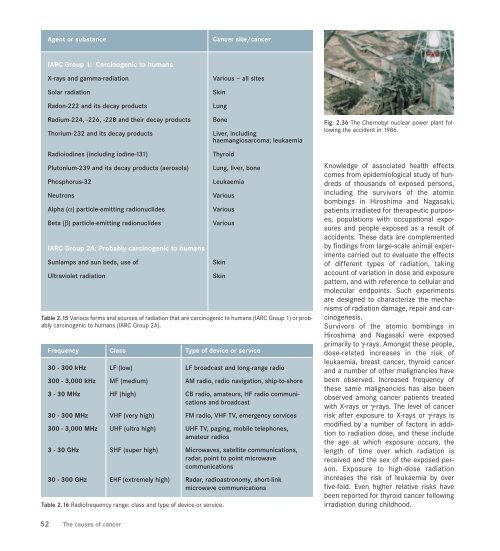world cancer report - iarc
world cancer report - iarc
world cancer report - iarc
You also want an ePaper? Increase the reach of your titles
YUMPU automatically turns print PDFs into web optimized ePapers that Google loves.
Agent or substance Cancer site/<strong>cancer</strong><br />
IARC Group 1: Carcinogenic to humans<br />
X-rays and gamma-radiation Various – all sites<br />
Solar radiation Skin<br />
Radon-222 and its decay products Lung<br />
Radium-224, -226, -228 and their decay products Bone<br />
Thorium-232 and its decay products Liver, including<br />
haemangiosarcoma; leukaemia<br />
Radioiodines (including iodine-131) Thyroid<br />
Plutonium-239 and its decay products (aerosols) Lung, liver, bone<br />
Phosphorus-32 Leukaemia<br />
Neutrons Various<br />
Alpha (α) particle-emitting radionuclides Various<br />
Beta (β) particle-emitting radionuclides Various<br />
IARC Group 2A: Probably carcinogenic to humans<br />
Sunlamps and sun beds, use of Skin<br />
Ultraviolet radiation Skin<br />
Table 2.15 Various forms and sources of radiation that are carcinogenic to humans (IARC Group 1) or probably<br />
carcinogenic to humans (IARC Group 2A).<br />
Frequency Class Type of device or service<br />
30 - 300 kHz LF (low) LF broadcast and long-range radio<br />
300 - 3,000 kHz MF (medium) AM radio, radio navigation, ship-to-shore<br />
3 - 30 MHz HF (high) CB radio, amateurs, HF radio communications<br />
and broadcast<br />
30 - 300 MHz VHF (very high) FM radio, VHF TV, emergency services<br />
300 - 3,000 MHz UHF (ultra high) UHF TV, paging, mobile telephones,<br />
amateur radios<br />
3 - 30 GHz SHF (super high) Microwaves, satellite communications,<br />
radar, point to point microwave<br />
communications<br />
30 - 300 GHz EHF (extremely high) Radar, radioastronomy, short-link<br />
microwave communications<br />
Table 2.16 Radiofrequency range: class and type of device or service.<br />
52 The causes of <strong>cancer</strong><br />
Fig. 2.36 The Chernobyl nuclear power plant following<br />
the accident in 1986.<br />
Knowledge of associated health effects<br />
comes from epidemiological study of hundreds<br />
of thousands of exposed persons,<br />
including the survivors of the atomic<br />
bombings in Hiroshima and Nagasaki,<br />
patients irradiated for therapeutic purposes,<br />
populations with occupational exposures<br />
and people exposed as a result of<br />
accidents. These data are complemented<br />
by findings from large-scale animal experiments<br />
carried out to evaluate the effects<br />
of different types of radiation, taking<br />
account of variation in dose and exposure<br />
pattern, and with reference to cellular and<br />
molecular endpoints. Such experiments<br />
are designed to characterize the mechanisms<br />
of radiation damage, repair and carcinogenesis.<br />
Survivors of the atomic bombings in<br />
Hiroshima and Nagasaki were exposed<br />
primarily to γ-rays. Amongst these people,<br />
dose-related increases in the risk of<br />
leukaemia, breast <strong>cancer</strong>, thyroid <strong>cancer</strong><br />
and a number of other malignancies have<br />
been observed. Increased frequency of<br />
these same malignancies has also been<br />
observed among <strong>cancer</strong> patients treated<br />
with X-rays or γ-rays. The level of <strong>cancer</strong><br />
risk after exposure to X-rays or γ-rays is<br />
modified by a number of factors in addition<br />
to radiation dose, and these include<br />
the age at which exposure occurs, the<br />
length of time over which radiation is<br />
received and the sex of the exposed person.<br />
Exposure to high-dose radiation<br />
increases the risk of leukaemia by over<br />
five-fold. Even higher relative risks have<br />
been <strong>report</strong>ed for thyroid <strong>cancer</strong> following<br />
irradiation during childhood.

















